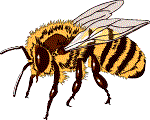Africanized Honeybee Fact vs. Fiction

In many ways, Africanized honeybees and European honeybees are similar.
Both:
- have the same appearance
- sting only once
- have the same venom
Avoiding Atack
You can reduce your chances of being stung by taking precautions:
- Put together safety plans for your home and place of work.
- Meet with neighbors to discuss the threat posed by Africanized honeybees and to increase community preparedness.
- Obtain bee sting kits (over-the-counter or prescription).
- Remain alert for bees while participating in outdoor sports, games and other activities.
- Look for bees in work areas before using power equipment.
- Check yards, pens and other buildings before using power equipment.
- Walk away and stay away if you find a swarm or nest.
- Run away in a straight line, cover your face and eyes with a jacket and hide in a car or house if a bee or swarm begins to chase you.
- Call a pest control company or emergency response agency to handle nests or swarms.
Africanized Honeybees also have their own identities
They...
- are more aggressive
- guard a larger area around their hives
- become upset more easily by humans and machinery
- respond faster and in larger swarms
- chase threatening humans and animals for as much as a quarter of a mile
Nest Sites
Africanized honeybees are not choosy about where they settle.
Likely nesting sites include:
- abandoned or rarely used vehicles
- empty containers
- places and objects with holes
- fences
- old tires
- trees
- in or around structures
- garages
- outbuildings
- sheds
Creating a Safer Enviroment
To make your environment safer and reduce your risk of a sting:
- Teach children to use caution and respect all bees.
- Teach children to notify a teacher or adult it they find a nest or swarm.
- Eliminate all potential nesting sites.
- Check the walls and eaves of all structures.
- Close off wall, chimney and plumbing-related gaps that are more than 1/8 inch large.
- Cover rain spouts, vents, etc. with 1/8" hardware cloth.
- Watch for regular entrance and exit routes used by swarms during spring, summer and fall.
Treating Stings
If stung by a bee or bees:
- Find a safe area as soon as possible.
- Remove the stinger quickly; scrape it out with a fingernail or credit card; do not release more venom by squeezing the stinger.
- Wash the affected area with soap and water. Apply an ice pack to relieve pain.
- See a doctor if breathing is difficult, if you are stung several times, or if you are allergic to bee stings.
Literature Cited
Extracted and adapted from "Bee Alert: Africanized Honeybee Facts," published by the Cooperative Extension, University of California Division of Agriculture and Natural Resources.
